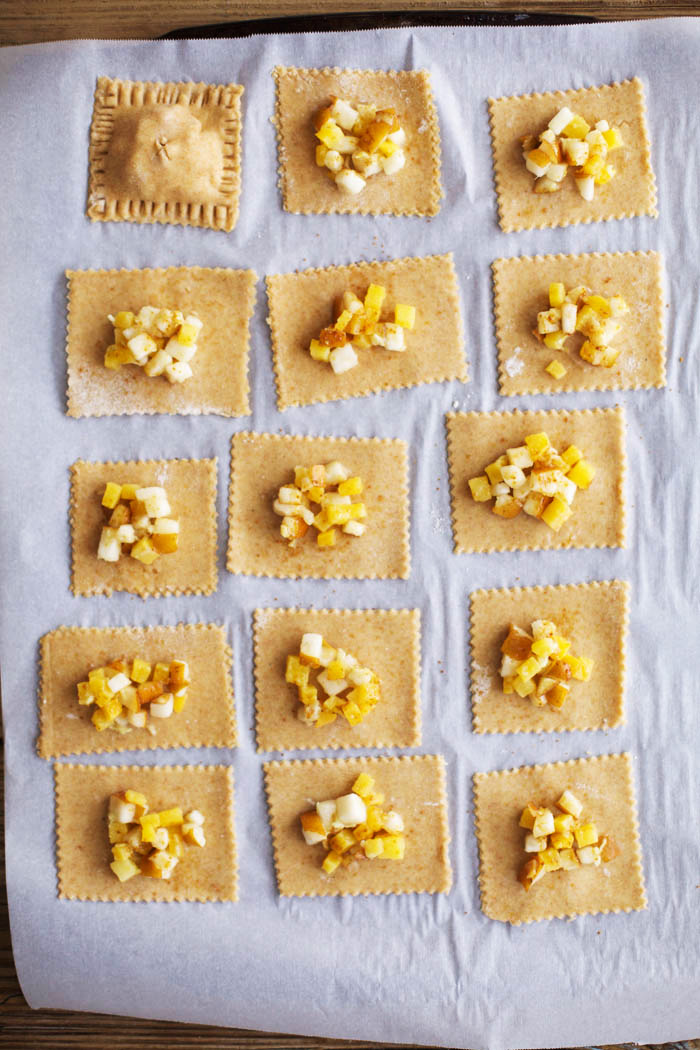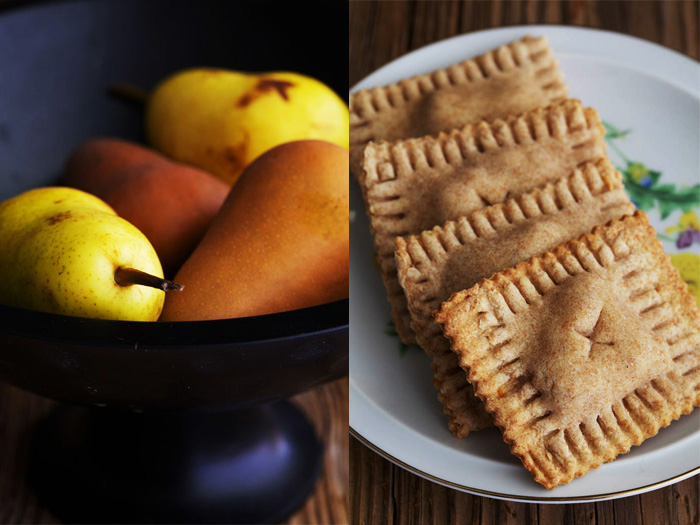
November 4th, 2015

I recently came back from a short stay in NYC with Masha (older daughter and Golubka photographer), where I was happy to get a glimpse of autumn with its turning trees and crisp air. Fall is something I miss a lot after being a resident of almost seasonless Florida for so many years.

All the falling leaves and a minor sniffle got me thinking about comforting soups, which are the best answer to being under the weather or any general cravings for warming, healing food.

This soup is simple in preparation, but full of powerful flavors and anti-inflammatory properties. I started with a play on chicken noodle soup, the classic ‘get well’ food, by using roasted spaghetti squash in place of noodles and making a nutritious broth. The broth is infused with the best of the best – turmeric, ginger, garlic, lemongrass and plenty of lemon. The sweetness of roasted carrots balances out the tartness and spiciness of the broth. Puy lentils complete the soup with body and substance. If you can get your hands on kaffir lime leaves, which can be found frozen at Asian markets, do not hesitate to include them, you’ll be in for a real treat.

I created this recipe as part of a healthy recipe package for Food & Wine online, see the detailed recipe here.
Tags: carrots, garlic, ginger, kaffir lime, lemon, lemongrass, lentils, soup, spaghetti squash, turmeric

March 23rd, 2014

Finally, our plans have been set in stone, the tickets have been bought and all the arrangements made. Paloma and I are flying to Moscow in a month. We’re staying in the city for a day to see some friends and then jumping on a train for the 24-hour ride down south to my hometown. Paloma has never yet been to Russia, and as hard as I imagine the 12 hour flight will be for her, I’m sure she’ll love the train. The rest of the family will join us at the end of May, when we intend to visit to a couple of other places in our region, including Sochi. We’ll be back in the States just in time for our cookbook release day – June 10th. I am getting very excited to see family and friends, all of whom I haven’t seen in years. I am also dreaming about all the delicious Russian food I will inevitably consume, prepared by some of the best cooks in my book – my mom, aunt, and girlfriends.

As any Russian, I grew up eating a lot of pies (pirozhki in Russian). Yeasty, doughy shells stuffed with meats, cabbage, eggs, rice, sorrel, or fruit. My favorites were always cabbage pies, that my mom makes with lightly sauteed cabbage and hard boiled eggs. The dough recipe for pirozhki is a frequent conversation subject among many Russian women – everyone has their own secret to the perfect dough. The question of ingredients, ratios, types of yeast, and oven temperature are not to be taken lightly. These days, I try to avoid pirozhki as much as I can, but individual homemade pies take me back to family tea times of my childhood like nothing else.
Since I often experiment with healthier, lighter varieties of doughs and fillings, I decided to share this lighter handpie recipe I’ve been coming back to often throughout the winter. And before peas and asparagus take over the greenmarkets, I thought I’d squeeze in some nourishing wintry flavors one last time. The pies are a curious combination of sweet and savory in one shell, combined with the ever-balancing flavor of ginger. They are great to enjoy with a meal, a cup of tea, or as a snack to take to work or school.
And since there are so many inspiring handpie recipes in the world already, I thought I’d share my (most likely incomplete) list:
1. Despite how it may seem now, summer is not far – soon will be time to make Laura’s Strawberry Handpies and maybe even the ice cream too?
2. Lindsey’s gluten free Cranberry Poptarts with Ginger Glaze will definitely be in my dreams until the next cranberry season.
3. Ashlae’s mouthwatering Blackberry Jam Pies so beautifully presented by her inspiring photography.
4. Beth is a true handpie master, making all kinds of flavors work in her pie fillings – Muscadine Rose Handpies, White Peach Rose Basil Handpies, Blueberry Basil Goat Cheese Handpies.
5. Shauna’s dreamy Savoury Handpies, which gave me the idea to use rutabaga in mine. 
Gingery Rutabaga and Pear Handpies
makes about 15 handpies
for the dough
1 1/4 cups sprouted or whole spelt flour, or half each sprouted/whole and light spelt flour
1 teaspoon sea salt
1/2 tablespoon coconut sugar
generous 1/4 cup coconut oil – solid
2-3 tablespoons ice-cold water
for the filling
1/2 small yellow onion – diced
1 inch piece of fresh ginger root – peeled and minced
couple sprigs fresh thyme – optional
1/8 rutabaga – peeled and diced
pinch of sea salt
freshly ground black pepper – optional
1 ripe but firm pear – cored and diced
coconut sugar for sprinkling
to make the dough
1. Place the flour, salt and sugar in a food processor and pulse to mix.
2. Cut the coconut oil into small pieces and add to the food processor. Pulse until incorporated.
3. Add 2 tablespoons ice water and pulse until the dough comes together when pressed between fingers. If it’s too dry, add one more tablespoon of water.
4. Form a disc with the dough, wrap it in plastic wrap and refrigerate while making the filling.
to make the filling
1. Warm up about 1 tablespoon olive oil in a medium skillet. Add onion, ginger and thyme and cook, stirring, at medium heat for about 4 minutes.
2. Add in rutabaga, salt and pepper and cook for another 7-8 minutes.
3. Let cool slightly, then stir in the pear.
to make the handpies
1. Preheat oven to 375F (190C). Roll the dough on a lightly floured surface, to 1/8-inch thickness. Cut the dough into any shapes you prefer, using a pastry or cookie cutter, ravioli stamp or a shot glass. Reshape, re-roll and cut more, until all of the dough is used up.
2. Arrange half of the cut pieces on a parchment paper covered baking sheet. Spoon a small amount of filling on each piece and lightly sprinkle with coconut sugar. Cover with the rest of the dough sheets and press around the edges with a fork.
3. Place the tray into the freezer for 10 minutes. Take it out and quickly score or prick the tops to allow the steam to escape. Bake for 15-20 minutes until golden around the edges. Let cool. Store for about 3 days in an airtight container at cool temperature.
Tags: ginger, pear, rutabaga, snack

October 15th, 2012
This post is also available in: French
Before it gets too cold, here are two ice cream ideas that are a little more hearty to set the mood for fall.
I’ve been wanting to try black sesame ice cream for a while now. At first, I was mostly intrigued by its deep asphalt grey colour, which is so uncharacteristic to ice cream or any dessert for that matter. Deviant ice cream. But then I thought about the flavour and realized that it would taste of halva and honey, and there was no stopping me then.
I also made some ginger ice cream to go with the grey batch. Ginger is another one of those warming, earthy flavours, which combines wonderfully with the sesame. I found the pairing of the two to be very comforting, almost soothing to have after a long day or to end a peaceful dinner.
Ginger Ice Cream
2 cans full fat coconut milk
1/2 teaspoon xanthan gum or 1 tablespoon arrowroot powder
1/2 cup agave syrup
1 teaspoon vanilla extract
1-inch peeled knob of ginger plus 1/4 cup grated ginger
In a bowl, mix together 1/4 cup of coconut milk with xanthan gum or arrowroot powder to form a thick slurry, set aside. Heat the rest of the milk, agave syrup, vanilla and the knob of ginger in a medium sized pan. Bring to a near boil, mix to dissolve the agave. Cover and leave to infuse until cool. Remove the knob of ginger and heat again. Add the slurry and whisk until smooth. Remove from heat and add grated ginger. Let cool completely at room temperature and refrigerate overnight. Put into an ice cream maker for 25 minutes or however long your brand of ice cream machine suggests.
Black Sesame Ice Cream
Black Sesame Paste
1/2 cup black sesame seeds
1/2 cup raw honey
Toast black sesame seeds in a dry frying pan over medium heat, shaking the pan often. Remove from heat immediately as you start smelling the toasted seeds. Grind the seeds in a coffee grinder or mortar and pestle. Mix honey with the seeds.
2 cans full fat coconut milk
2 tablespoons arrowroot powder or 1/2 teaspoon xanthan gum
1/2 cup coconut sugar
pinch of salt
4 tablespoons black sesame paste
In a bowl, mix together 1/4 cup coconut milk and arrowroot powder, making a slurry. In a medium sized pan, combine the rest of the milk, sugar and salt and bring to a boil. Lower the heat, stir in the arrowroot/xanthan slurry and simmer for 1-2 minutes, stirring constantly. Remove from heat. Mix in the black sesame seed paste thoroughly. Let cool completely at room temperature and refrigerate overnight. Put into an ice cream maker for 25 minutes or however long your brand of ice cream machine suggests.
To make raw ice cream, use this recipe for vanilla ice cream and add about the same amount of grated ginger or sesame paste. You may want to reduce the amount of agave for the black sesame ice-cream or use 1/2 cup of coconut sugar instead.
Tags: black sesame, dessert, ginger, ice cream, raw food, recipe, vegan




